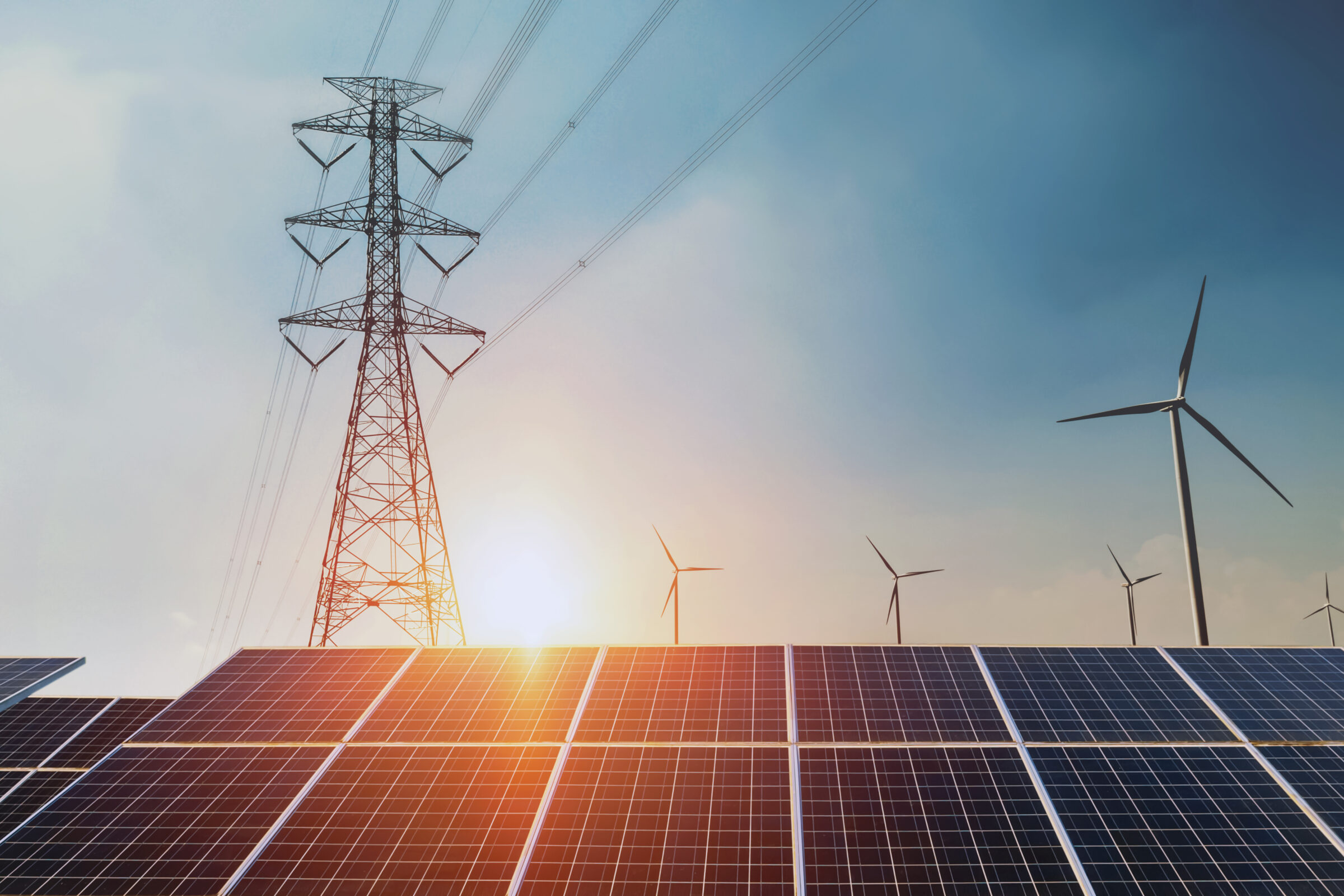- Transmission & Power Markets
- Comments & Testimony
ACORE Urges FERC to Prioritize Interregional Transmission and All of the Above Energy in Achieving Grid Reliability
UNITED STATES OF AMERICA FEDERAL ENERGY REGULATORY COMMISSION
Meeting the Challenge of Resource Adequacy in )
Regional Transmission Organization and Independent )
System Operator Regions )
Docket No. AD25-7-000
COMMENTS OF THE AMERICAN COUNCIL ON RENEWABLE ENERGY
The American Council on Renewable Energy (“ACORE”) submits these pre-technical conference comments in response to the Third Supplemental Notice of Commissioner-Led Technical Conference (“Supplemental Notice”) issued by the Federal Energy Regulatory Commission (“Commission”) in the above-captioned docket on June 2, 2025. We commend the Commission for holding this Technical Conference on this crucial topic and are submitting these comments to address two specific issues. ACORE plans to submit more in-depth post-technical conference comments.
Transmission Expansion is Essential for Reliability and Resource Adequacy
The reliability benefits of transmission, especially interregional transmission, are well-documented, yet the supplemental notice poses only three questions related to transmission (Panel 1, Question 10; Panel 2, Question 6; and Panel 5, Question 6). ACORE urges the Commission and panelists to engage in a more fulsome discussion of the contributions of transmission to reliability and resource adequacy value. Well-planned expansions of transmission can greatly enhance existing resources’ capacity value by accessing the temporal differences in resource availability and levels of demand.1 An example of this value is seen in the emerging evidence that transmission limitations contributed to MISO’s May 25 instructions for load shedding in the Greater New Orleans region.2 Moreover, this technical conference is being held less than a year after the North American Electric Reliability Corporation (“NERC”) issued the Interregional Transfer Capability Study (“ITCS”), identifying 35 gigawatts (GW) of recommended prudent additions for interregional transmission to ensure reliability.3 As ACORE explained in our comments on the ITCS, the 35 GW measure is likely an understatement of the amount needed for reliability.4
Along with a much-needed interregional transmission expansion, an expanded deployment of grid-enhancing technologies (GETs) and high-performance conductors (HPCs) would provide near-term reliability benefits. Unfortunately, none of the questions in the Supplemental Notice address these technologies. Yet, in the ITCS, NERC also recommended that plans to increase transfer capability consider the inclusion of upgrades to the transmission infrastructure, such as through reconductoring, as well as using dynamic line ratings and advanced power flow controls.
An ACORE-commissioned report from The Brattle Group and Grid Strategies documents real-world experiences demonstrating that advanced transmission technologies (“ATTs”) can provide all of the seven benefits of transmission identified in Order No. 1920, including the reliability benefits of a reduced loss of load probability or lower reserve margin (Benefit 2) and mitigation of extreme weather events and unexpected system conductions (Benefit 6).5 In particular, “HPCs and GETs can reveal additional capacity on adjacent or interconnected lines, enabling system operators to reroute power efficiently and deal with unexpected system conditions, including those associated with extreme weather events.”6
A Reliable Grid Requires an All-of-the-Above Approach
Meeting the challenges identified by the Commission in the Supplemental Notice requires holistic policies that recognize the value and shortcomings of all resources. Just as there is no perfect generation resource, each resource has essential and valuable attributes. Terms such as “dispatchable,” “baseload,” and “variable” are not the only or even the best characteristics to reflect a resource’s reliability value. Many resources have faced impediments to their availability during times of grid stress regardless of their categorization. The Commission’s recently released Summer Energy Market and Electric Reliability Assessment identifies the following concerns for this summer, which encompass multiple different resource classes:7
- Hydropower generation in the West may be limited by high spring melt rates that result in a diminished summer water supply.
- Low water levels, the risk of saltwater intrusion, and increased water temperatures in coastal rivers due to regional drought conditions could also pose operational risks for thermal generators that use once-through-cooling equipment.
- Five nuclear generating units will be on extended outages, including some unplanned, for at least a portion of this summer.
- Reliability risks from inverter-based resources (“IBRs”) may continue during the time before new standards are developed and implemented.
Resources also have unique risks during winter periods with natural gas resources having experienced equipment failures and fuel supply constraints in past periods of extreme cold.8
It is also important to recognize that inverter-based resources provide many Essential Reliability Services, including voltage support, frequency regulation, and ramping capabilities.9 These resources’ use of power electronics to interface with the grid enables them to be more flexible. NERC includes among the features of IBRs their ability to provide “very fast and flexible ramping” and “very fast frequency control.”10
It is also important to recognize that expansions of energy storage, both stand-alone and hybrid, is proving essential for reliability. The Commission reported that “since the 2024 Summer Reliability Assessment, energy storage installed capacity increased by 94%, while available capacity increased by 358%.”11 NERC observed in its 2025 Summer Reliability Assessment that in “Texas, California, and across the U.S. West, the influx of battery energy storage systems (BESS) in recent years has markedly improved the ability to manage energy risks during challenging summer periods.”12
Conclusion
In sum, generation, storage, transmission, and demand-response are all essential components of a reliable grid and should be viewed as an ecosystem that optimizes the value of all resources. Failing to significantly expand interregional transmission, limited use of ATTs, and misleading characterizations or exclusions of resource types will all be detrimental to reliability and increase consumer costs. ACORE therefore urges the Commission to take a comprehensive approach to reliability in the upcoming Technical Conference and future actions.
Respectfully submitted,
/s/ Elise Caplan
Elise Caplan
Vice President, Regulatory Affairs
American Council on Renewable Energy
1150 Connecticut Ave NW, Suite 401
Washington, D.C. 20036
June 3, 2025
1 See Michael Goggin and Zach Zimmerman, Billions In Benefits: A Path For Expanding Transmission Between MISO and PJM, Grid Strategies LLC, prepared for the American Council on Renewable Energy (Nov. 2023) at 8, https://acore.org/resources/billions-in-benefits-a-path-for-expanding-transmission-between-miso-and-pjm/; Adria E. Brooks, Alison Silverstein, Rob Gramlich, Resource Adequacy Value of Interregional Transmission, Grid Strategies LLC, https://cleanenergygrid.org/wp-content/uploads/2025/06/GridStrategies_RAValueInterregionalTx_250601.pdf.
2 See for example, Logan Atkinson Burke, Alliance for Affordable Energy director: After outages, here’s how regulators can keep lights on (May 30, 2025), https://www.nola.com/opinions/guest-column-louisiana-power-outages/article_a9d3463e-5d9c-42cb-a146-e7827a2a9d08.html.
3 Interregional Transfer Capability Study (ITCS), Strengthening Reliability Through the Energy Transformation, Final Report, North American Electric Reliability Corporation (November 2024), https://www.nerc.com/pa/RAPA/Documents/ITCS_Final_Report.pdf.
4 Comments of the American Council on Renewable Energy, Interregional Transfer Capability Study: Strengthening Reliability Through the Energy Transformation, Docket No. AD25-4-000 (February 25, 2025), https://acore.org/resources/acore-comments-on-the-nerc-interregional-transfer-capability-study/.
5 T. Bruce Tsuchida, Linquan Bai, S. Ziyi Tang, and Jay Caspary, Incorporating GETs and HPCs into Transmission Planning Under FERC Order 1920 (April 2025), The Brattle Group and Grid Strategies LLC, prepared for the American Council on Renewable Energy https://acore.org/resources/incorporating-gets-and-hpcs-into-transmission-planning-under-ferc-order-1920/.
6 Ibid. at 24.
7 Summer Energy Market and Electric Reliability Assessment 2025, A Staff Presentation to the Commission (May 15, 2025), https://www.ferc.gov/media/2025-summer-energy-market-and-electric-reliability-assessment.
8 The February 2021 Cold Weather Outages in Texas and the South Central United States: FERC, NERC, and Regional Entity Staff Report, (November 2021), https://ferc.gov/media/february-2021-cold-weather-outages-texas-and-south-central-united-states-ferc-nerc-and; Inquiry into Bulk-Power System Operations During December2022 Winter Storm Elliott: FERC, NERC, and Regional Entity Staff Report, (October 2023), https://www.ferc.gov/media/winter-storm-elliott-report-inquiry-bulk-power-system-operations-during-december-2022.
9 Sources of Essential Reliability Services, Milligan Grid Solutions, https://milligangridsolutions.com/Sources%20of%20Essential%20Reliability%20Grid%20Services%20Fact%20Sheet.pdf.
10 An Introduction to Inverter-Based Resources on the Bulk Power System North American Electric Reliability Corporation (June 2023), https://www.nerc.com/pa/Documents/2023_NERC_Guide_Inverter-Based-Resources.pdf.
11 Summer Energy Market and Electric Reliability Assessment 2025, Footnote 95.
12 North American Electric Reliability Corporation, 2025 Summer Reliability Assessment, (May 2025), at 7, https://www.nerc.com/pa/RAPA/ra/Reliability%20Assessments%20DL/NERC_SRA_2025.pdf.
Join leaders from across the clean energy sector.

What will our next 20 years look like? Here’s the truth: they’ll be better with ACORE at the forefront of energy policy.
Shannon Kellogg
Amazon Web Services (AWS)
